What Year Will Cicadas Come Again
Skip to a section: Broods | Your Town | Pre Emergence Signs | Magicicada Species.
17 & 13 Yr Periodical Cicadas
This page is strictly for Magicicada periodical cicadas, aka 17 & xiii-yr cicadas, aka "locusts" (read why they're called locusts).This does not cover annual cicada species in Northward America and other parts of the world.
Magicicada Chorus. Recorded in New Jersey, Brood Ten (2004) by Dan Mozgai:
News
Breed XIII (13) and Brood XIX (19) volition both emerge in 2024. See yous then!
Magicicada Breed Chart
The Brood Chart features the names of the broods (Roman numerals), their life cycle length, when they volition emerge next, which states they'll emerge in, links to Maps, the species that will emerge, and other information. Click the maps for larger, detailed maps.
| Breed | 17 or 13 | Year | Stragglers Probable | States & Species |
|---|---|---|---|---|
| I (1) | 17 | 1961, 1978, 1995, 2012, 2029 | 2025 (-four), 2028 (-1) | Species: M. septendecim, Chiliad. cassini, M. septendecula. States: TN, VA, WV 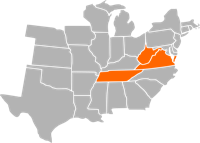 |
| 2 (2) | 17 | 1962, 1979, 1996, 2013, 2030 | 2026 (-4), 2029 (-1) | Species: M. septendecim, M. cassini, One thousand. septendecula. States: CT, GA, MD, NC, NJ, NY, OK, PA, VA 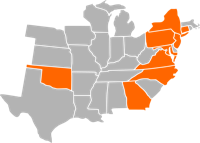 |
| Iii (3) | 17 | 1963, 1980, 1997, 2014, 2031 | 2027 (-four), 2030 (-1) | Species: M. septendecim, M. cassini, M. septendecula. States: IA, IL, MO 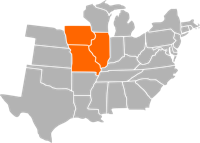 |
| IV (iv) | 17 | 1964, 1981, 1998, 2015, 2032 | 2028 (-4), 2031 (-i) | Species: M. septendecim, M. cassini, M. septendecula. States: IA, KS, MO, NE, OK, TX 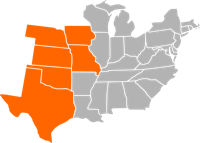 |
| V (5) | 17 | 1965, 1982, 1999, 2016, 2033 | 2029 (-4), 2032 (-1) | Species: Grand. septendecim, M. cassini, M. septendecula. States: LI NY, MD, OH, PA, VA, WV 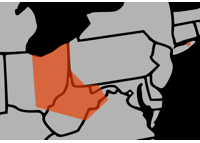 |
| Vi (6) | 17 | 1966, 1983, 2000, 2017, 2034 | 2030 (-4), 2933 (-ane) | Species: Grand. septendecim, M. septendecula. States: GA, NC, SC, WI, OH 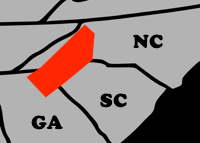 |
| 7 (7) | 17 | 1967, 1984, 2001, 2018, 2035 | 2031 (-4), 2034 (-1) | Species: Chiliad. septendecim. States: NY 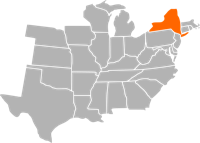 |
| Viii (8) | 17 | 1968, 1985, 2002, 2019, 2036 | 2032 (-4), 2035 (-1) | Species: M. septendecim, M. cassini, Chiliad. septendecula. States: OH, PA, WV and OK 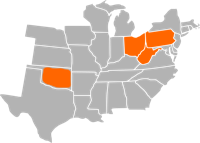 |
| Nine (ix) | 17 | 1969, 1986, 2003, 2020, 2037 | 2033 (-4), 2036 (-1) | Species: Thousand. septendecim, Chiliad. cassini, G. septendecula. States: NC, VA, WV 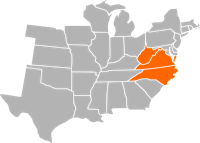 |
| X (10) | 17 | 1970, 1987, 2004, 2021, 2038 | 2020 (-1), 2034 (-4), 2037 (-1) | Species: Yard. septendecim, Thousand. cassini, M. septendecula. States: DE, GA, IL, IN, KY, Physician, MI, NC, NJ, NY, OH, PA, TN, VA, WV, Washington 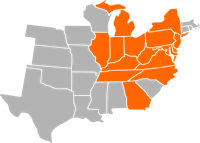 |
| XIII (13) | 17 | 1956, 1973, 1990, 2007, 2024 | 2020 (-4), 2023 (-1) | Species: M. septendecim, M. cassini. States: IA, IL, IN, MI, WI 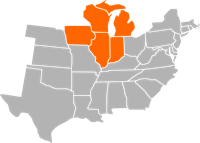 |
| Xiv (fourteen) | 17 | 1957, 1974, 1991, 2008, 2025 | 2021 (-4), 2024 (-1) | Species: M. septendecim, M. cassini, G. septendecula. States: GA, IN, KY, MA, Dr., NC, NJ, NY, OH, PA, TN, VA, WV 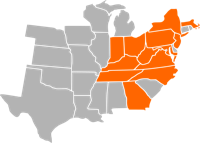 |
| XIX (19) | 13 | 1972, 1985, 1998, 2011, 2024 | 2020 (-four), 2023 (-1) | Species: M. tredecim, Grand. neotredecim, Grand. tredecassini, Yard. tredecula. States: AL, AR, GA, IA, IL, IN, KS, KY, LA, Dr., MO, MS, NC, OK, SC, TN, VA 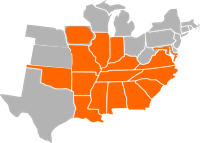 |
| XXII (22) | 13 | 1975, 1988, 2001, 2014, 2027 | 2023 (-4), 2026 (-one) | Species: One thousand. tredecim, M. tredecassini, M. tredecula. States: KY, LA, MS, OH 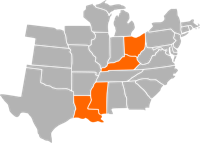 |
| XXIII (23) | thirteen | 1976, 1989, 2002, 2015, 2028 | 2024 (-four), 2027 (-1) | Species: M. tredecim, M. neotredecim, M. tredecassini, 1000. tredecula. States: AR, IL, IN, KY, LA, MO, MS, TN 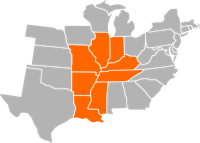 |
When will they emerge?
Generally speaking, these cicadas will brainstorm to sally when the soil 8″ beneath the ground reaches 64 degrees Fahrenheit (Heath, 1968). A nice, warm rain volition often trigger an emergence. They typically sally in May but have been known to emerge in late April or early June. It all depends on the weather.
What should you look for before they emerge?
Chimneys / Turrets
Look for cicada chimneys a.yard.a. turrets. These are structures cicadas build out of the soil, positioned higher up the hole where they will sally.
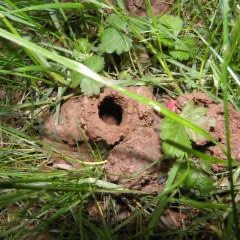
Holes
Look for holes in the diameter of an developed's finger near the root system of a tree. These are sure signs that cicadas volition emerge in the area.
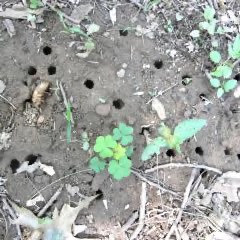
Cicadas Under Stones & Slates
You might discover some cicada nymphs while turning over stones or when performing landscaping chores.
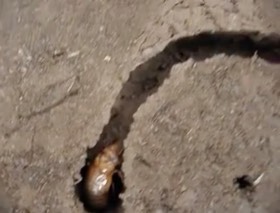
What practise they wait similar when they emerge:
Here is a smashing video of Magicicada nymphs once they have emerged from the ground:
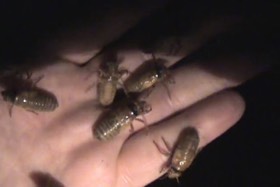
This is a recently emerged nymph crawling upwardly a tree. Annotation that its eyes are ruby.
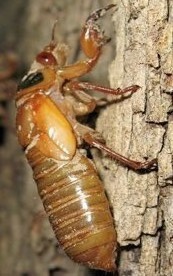
Once cicadas nymphs accept emerged from the ground, they will endeavour to find a tree (or similar vertical surface), and so begin the process of shedding their quondam nymph skins (ecdysis), expanding their wings, and changing to their adult coloring. Scout this astonishing transformation.
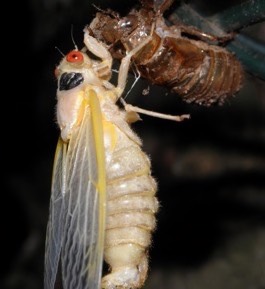
How to tell the divergence between the 7 Magicicada species:
Left to right: Magicicada cassini, Magicicada septendecula, Magicicada septendecim:
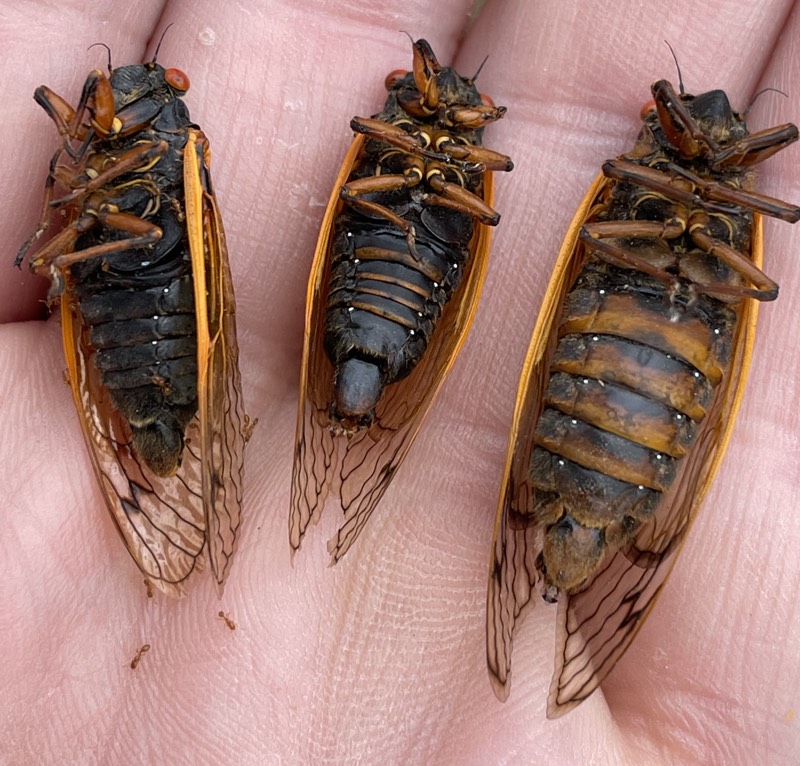
The first way is based on the Brood. Accept a expect at the Brood chart to a higher place, and see which species announced with the Brood.
There are three bones types of Magicicada: "'Decims", "'Cassini" and "'Deculas".
"Decims" aka Pharaoh Cicadas
In that location are three species in this category:
- Magicicada septendecim (Linnaeus, 1758). 17-twelvemonth life cycle. Broods: I-X, XIII, XIV.
- Magicicada neotredecim Marshall and Cooley 2000. 13-year life cycle. Broods: Xix, XXIII.
- Magicicada tredecim (Walsh and Riley, 1868). xiii-year life cycle. Brood: Nineteen, XXII, XXIII.
Their songs are very similar, however, when Chiliad. neotredecim & Chiliad. tredecim emerge in the same location, M. neotredecim's vocal takes a college pitch. Sounds like "Pharaoh, Pharaoh!".
Visual Appearance:
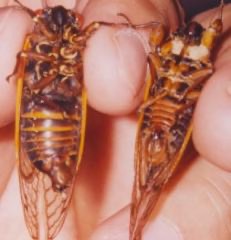
Male on left; Female on right.
M. neotredecim & Chiliad. septendecim accept broad orange stripes with more orange than blackness on their abdomens.
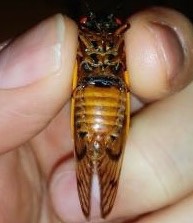
M. tredecim, past comparison, have nigh entirely orangish abdomens.
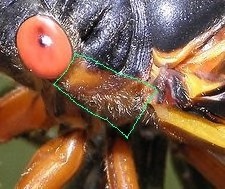
1000. septendecim cicadas also have an expanse of orange coloring between the eye and the wing (pronotal extension).
"Cassini" aka Dwarf Cicadas
There are 2 species in this category:
- Magicicada cassini (Fisher, 1851). 17-twelvemonth life cycle. Broods: I-V, 8-X, Xiii, XIV.
- Magicicada tredecassini Alexander and Moore, 1962. thirteen-year life cycle. Broods: XIX, XXII, XXII.
Their songs are essentially identical:
M. cassini Call and Court:
Notation how it makes a quick burst of sound, followed by some rapid clicks.
Visual Appearance:
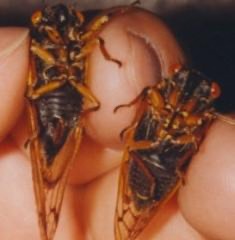
Female on left; Male on correct.
M. tredecassin & Grand. cassini cicadas accept black abdomens with virtually no orange at all. Orange stripes are possible in the mid-w (important to note for Breed Iv).
"Decula"
There are 2 species in this category:
- Magicicada septendecula Alexander and Moore, 1962. 17-year life bicycle. Broods: I-VI, VIII-Ten, XIII, XIV.
- Magicicada tredecula Alexander and Moore, 1962. 13-year life bike. Broods: 19, XXII, XXIII.
Their songs are essentially identical:
Grand. tredecula Call:
Notation the "tick, tick, tick" rhythm of the call.
Visual Appearance:
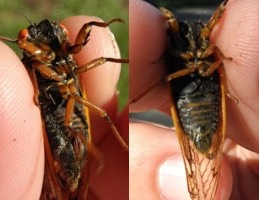
Female on left; Male on right.
M. septendecula & M. tredecula have stripes that feature more blackness than orange. Otherwise, they're very similar to Thousand. cassini.
How to figure out if they're coming to your boondocks?
- Verify that they're coming to your state. Check the Magicicada Brood Chart on this page.
- Check Cicada Brood Maps linked from this page to see if they're coming to your full general expanse.
- Check to see if they're coming to your neighborhood. Expert sources include:
- Cheque the Cicada Central Magicicada Database to run into the counties where cicadas accept appeared in the past.
- Ask someone who lived there 17 (or thirteen) years before.
- Old timers (hint: erstwhile timers unremarkably phone call them locusts).
- Check your local Library for old paper articles.
- Check with a local college: contact the entomology, forestry, or agriculture-related departments.
- Your local national, state, canton and boondocks parks department (parks and rec). Some county parks departments plan events effectually cicada emergences.
- When volition they emerge?
- They volition sally sometime in the Bound, for certain.
- They typically emerge in one case the soil 8 inches (twenty cm) below the surface gets to 64 degrees Fahrenheit (eighteen degrees Celcius). At that temperature, they will kickoff earthworks their tunnels to the surface. After a couple of days with above-basis temperatures nearly the 80's F, and subsequently a adept rain, they will definitely sally. Read this paper for more info: Thermal Synchronization of Emergence in Periodical "17-year" Cicadas (Homoptera, Cicadidae, Magicicada) past James Edward Heath, American Midland Naturalist, Vol. 80, No. ii. (October., 1968), pp. 440-448.
- Cicadas in sunny areas of your yard will emerge earlier cicadas in shady areas.
- Cicadas in the southern-most states volition sally before cicadas in northern states.
- Yous tin try the Cicada Emergence Formula too.
- If you don't want them practise damage your young / ornamental trees
- Spray them off with a garden hose.
- Foil effectually the trunk (to keep them from itch up) (thanks Deborah).
- Insect barrier tape.
- Netting placed around & over the tree. "Insect barrier netting". "Fruit tree covers".
- Bagpipes (no joke, it worked at my friend's nuptials).
- Don't use pesticide – we like all insects (especially pollinating bees).
- Are you lot scared of insects?
- Unlike some other insects & arthropods. cicadas are not poisonous or venomous.
- Endeavor a chapeau, an umbrella, a bee-keepers' outfit, a suit of armor…
- They're coming, and they're going to ruin my wedding!
- Try our Cicada Wedding Planner
Questions near the Brood Chart
Question: Why practise I take cicadas in my neighborhood, but your chart indicates that I shouldn't?
Reply: Some possibilities: 1) they are stragglers, periodical cicadas that emerge too before long or late, 2) they are non periodical cicadas, but are a different North American species, iii) you live on a continent other than North America, in which instance, effort one of these pages, or 4) SURPRISE! The U.Due south. is a large place and some cicada populations have yet to be documented.
Question: Why don't I have periodical cicadas in my area, but the information on your website indicates that I should?
Reply: Two possibilities: one) they went extinct or otherwise died off in your area, or 2) they aren't everywhere in a land – unremarkably there are large gaps in their range.
Question: What are stragglers?
Answer: Stragglers can emerge ane or 4 years early on or one or 4 years late. Don't be surprised if you see some periodical cicadas emerge earlier than planned this twelvemonth. 17-year breed members are nearly probable to straggle 4 years early on, and 13-twelvemonth brood members are most probable to straggle 4 years late. Straggler probability chart.
Question: Why are there no Breed Xi, XII, XV, XVI… ?
Answer: Perhaps you've noticed in that location are no Broods Xi (11), XII (12), Fifteen (15), Sixteen (sixteen), XVII (17), XVIII (18), Twenty (20), XXI (21), XXIV (24), etc. Don't worry about that. They never existed or are extinct (11, XXI).
More Magicicada websites:
- For much more than information about 17-yr cicadas visit Cicadas @ UCONN (formerly Magicicada.org). The maps on this page link to that site.
- The Cicada Safari App is available for Android and Apple tree devices ðŸ"±. Apply it to meet where people are finding cicadas, and to report your own sightings.
- Check the Cicada Central Magicicada Database to run across the counties where cicadas accept appeared in the by. For more information about this database and cicada research in general, visit the Simon Lab website.
More Magicicada Information
- Signs periodical cicadas are about to sally.
- Utilise the Journal Cicada Emergence Checklist for the Maximum Magicicada Experience
- All cicada questions that are frequently asked.
- A video to help you tell the difference between the species
- Pictures of Magicicadas
- The 17 Virtually Interesting Periodical cicada facts
- Blog posts about Magicicadas (390+ Posts!)
Source: https://www.cicadamania.com/cicadas/where-will-17-13-year-periodical-cicadas-emerge-next/
0 Response to "What Year Will Cicadas Come Again"
Post a Comment